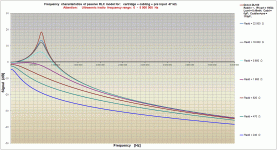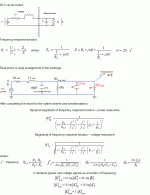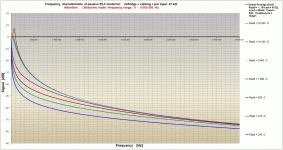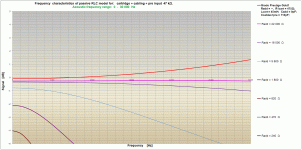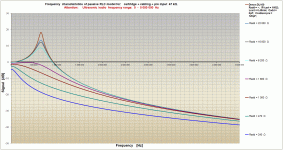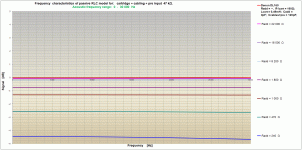I have a Denon DP-62L TT I'm going to try and bring up in the near future. It came with the straight arm. I've heard this arm is relatively light, and should be used with a high-compliance cartridge. True? I also have a new DL-160 high output moving coil cartridge. Would this one be too stiff to use with the straight arm? If so, are there any measures that can be taken (say, extra mass added to the arm) that would make it more compatible? What sorts of arms are good matches for a DL-160, for that matter?
I have a Denon DP-62L TT I'm going to try and bring up in the near future. It came with the straight arm. I've heard this arm is relatively light, and should be used with a high-compliance cartridge. True? I also have a new DL-160 high output moving coil cartridge. Would this one be too stiff to use with the straight arm? If so, are there any measures that can be taken (say, extra mass added to the arm) that would make it more compatible? What sorts of arms are good matches for a DL-160, for that matter?
It doesn't matter the shape of the arm.....S, J, or straight. The 160 cart might be a bit stiff on it. If so, you can always add some mass to the arm until you can get the resonate level in around the 10hz level. pretty nice DD table BTW
I have the DL110 and while the compatibility is listed as 47K, I remember somewhere seeing that 10k was the actual optimum. Damned if I can find teh reference to that though - and I've looked a few times!
It was on some kind of explanatory site for cartridge loading, talked about how all manufacturers said 47k for MM carts, but when you actually did measurements and calculations, the actual optimum was often different. The example used was the 160 or 110.
Sorry about teasing you with this info!
It was on some kind of explanatory site for cartridge loading, talked about how all manufacturers said 47k for MM carts, but when you actually did measurements and calculations, the actual optimum was often different. The example used was the 160 or 110.
Sorry about teasing you with this info!
I think I remember some folks in the Simplistic RIAA preamp thread fooling around with values as low as 1k. At any rate, it looks like it'll be worthwhile socketing the load resistors on my RIAA preamps for awhile until I get something worked out. I'm currently using 16k2 for my Grado Gold, and that appears to be working ok. Contacts extracted from a machined contact wire wrap socket work admirably for this purpose.
I think I remember some folks in the Simplistic RIAA preamp thread fooling around with values as low as 1k. At any rate, it looks like it'll be worthwhile socketing the load resistors on my RIAA preamps for awhile until I get something worked out. I'm currently using 16k2 for my Grado Gold, and that appears to be working ok. Contacts extracted from a machined contact wire wrap socket work admirably for this purpose.
16K sounds a bit low in load for a Grado of stock configuration. My thoughts would be that the highs are too rolled off. If it does sound balanced there, might be an issue futher down the chain of rising frequency response. Adding a low-out stylus assembly to a high out Grado body does require lowering the load to the range you have. 12-22k range.
(low out stylus assemebly would be Z2, MCZ, TLZ for 1.5mv motors. high-out motors are found in the prestige, black through gold series, 4-5mv range)
Hope this helps
Marc
Simulations show a nasty ultrasonic peak in the response with typical cable capacitance and 47k. 16k damps this out. I don't notice any excessive roll-off of the high frequencies. When I work out some other issues. I'll dig out my test record and do some sweeps with a digital scope.
Any suggestions for load resistor for the DL-160?
Plus minus 1800 ohm. Around ofcourse, may be even 1kohm, dependig on real capacity of your interconnecting wires. This is not fooling around. Normal for MC High carts. They are specific. Forget 47 kohm. MM input ? - yes, but never 47 kohm for any MC High cart. It is also my problem with my two MC High cartridges, Goldring Eroica High and Benz Micro Glider M2 - proble solved already. Please look at the family of curves attached. Low values of resistance are required due to strong ultrasonic resonances. Regards.
Attachments
16K sounds a bit low in load for a Grado of stock configuration. My thoughts would be that the highs are too rolled off. If it does sound balanced there, might be an issue futher down the chain of rising frequency response. Adding a low-out stylus assembly to a high out Grado body does require lowering the load to the range you have. 12-22k range.
(low out stylus assemebly would be Z2, MCZ, TLZ for 1.5mv motors. high-out motors are found in the prestige, black through gold series, 4-5mv range)
Hope this helps
Marc
Maybe 22K ? 16K is not so bad however. Pls look at the attachments. Regards.
Attachments
Any suggestions for load resistor for the DL-160?
8K2 with a neutral tone TT and arm. Had that cart. We took it down to 1-2k2 when the TT combination was rather bright.
8K2 with a neutral tone TT and arm. Had that cart. We took it down to 1-2k2 when the TT combination was rather bright.
Hm, MC high carts are very specific designs, different from normal MCs and MMs, most users are completely unaware of that fact. These MCHs must be treated in a different way if connected to 47K MM pre input.
This is a special case and must be treated with special care.
MCHighs have much, much lower inductance than MMs, for example – attention please - 0,2 mH for Goldring Eroica MCHigh or even much worse - 0,02 mH for BenzM Glider M2 - now - compared to 500 mH !! or even 700 mH !! of MM carts, but are connected with their extremely small inductance to 47K MM input !!
Together with typical capacitance of interconnecting stuff (cables, arm, shell wires, cap of pre input) let’s say, between 80 pF (my case is 90pF) to 250 pF this is a radio circuit with quite good Q and very strong resonance curve, again, not dumped high frequency resonance circuit !
Shunt resistance in this special case is vitally important from point of view of damping ultrasonic and/or radio frequencies resonances. Unless one wants to be able to hear strange, discrete parasitic radio noises, partially somehow AM demodulated on nonlinearities of pre input (which was my case with Benz Micro Glider M2), or threat of parasitic oscillations (again my case with BM Glider M2 too), strange waving quality of sound in acoustic range (which was also my case with this Glider) .
One should be very careful with shunt resistances higher than few Kilos (2-3-4 Kohm) with MCHighs connected to MM input.
Please look at my both simulations attached for Denon DL160.
Attachments
Shouldn't you know the individual input capacitance, the full response and Riaa correction out of band zero or not of each phono stage to thoroughly simulate? With Lipshitz won't be any energy passing up there you show for instance even if the phono is 1MHz loop capable. In my experience the 160 is best balanced at 8k2 if no brightness effects come up in the system (mechanical reasons or even due to a passing bad combination of those parameters you show). Else I used 1k-2K2. Which is something you also recommend. The 160 is recently discontinued BTW. Only the 110 remains.
P.S. Welcome to the forum by the way, and use normal fonts if you may.
P.S. Welcome to the forum by the way, and use normal fonts if you may.
...... not dumped ........
Sorry, should be "not damped", unfortunately prices of all those cartridges are not dumped.
Shouldn't you know the individual input capacitance, the full response and Riaa correction out of band zero or not of each phono stage to thoroughly simulate? With Lipshitz won't be any energy passing up there you show for instance even if the phono is 1MHz loop capable. In my experience the 160 is best balanced at 8k2 if no brightness effects come up in the system (mechanical reasons or even due to a passing bad combination of those parameters you show). Else I used 1k-2K2. Which is something you also recommend. The 160 is recently discontinued BTW. Only the 110 remains.
P.S. Welcome to the forum by the way, and use normal fonts if you may.
Thank you, sorry for the font, just copy and pasted from MsWord.
Let’s forget all of these HF resonances for a while.
Now, by changing the value of this external shunt resistance we play the game not only with left hand partner, meaning cart, gram, wires (on this part, within audible range, according to simulations and practice we are changing only audible, flat level of signal damping not the brightness of audible sound), but also with right hand partner, meaning pre input.
Main assumption for engineers designing MM pre input circuitry is that the external source of signal (MM cart) will have its inner impedance at about 47K level. So if, for specific preamplifier, inner pre-input circuitry elements values are calculated, generally speaking, “tight” to comply with this assumption, any other than plus minus 47 K external resistance connected to MM input will have an impact (stronger or weaker depending on degree of “tightness” in calculating certain pre-in elements values) on frequency characteristics of pre-amplifier itself.
Things are getting worse with older designs (considering slow drifting, changing values of passive elements in time) when the preamp is getting older and is getting more vulnerable.
If (only for Mc High connected to MM input) there is an audible difference in brightness of sound between 8K and 1K external resistances, this in my opinion might mean only one thing, there is an impact on this specific preamp MM input and its specific MM pre-input frequency characteristics - so, in conclusion, this specific MM input does not fit to MC High cartridges.
I think it is quite normal that such a hybrid as MC High cartridge is a source of bunch of problems (HF resonances, MM inputs designed a time ago for another purposes, designers were not able to anticipate the invention of MC High carts) with its fitting to not quite compatibile environment. Manufactures’ information about their MCHighs’ load impedances is also sometimes misleading and ambiguous.
All well but 8k2 was better balanced in same input and better TT. There was no 'lost constant' zero in the Riaa filter nor loop feedback to give anything beyond 150kHz BW. It may well be brighter for RF tank resonance reasons in other systems but not in that one. We were giving 1k-2k2 recommendation as general to avoid mishaps. If all filtered well, 8k2 was open and tame with the 160. A bit better but audible so than lower. For MM a variable (trimmer) load was recommended.
Simulations show a nasty ultrasonic peak in the response with typical cable capacitance and 47k. 16k damps this out. I don't notice any excessive roll-off of the high frequencies. When I work out some other issues. I'll dig out my test record and do some sweeps with a digital scope.
Correct, the ultrasonic peak should be in the 55-60KHZ range. I'm not sure there is any material recorded up there, nor will your speakers produce that tone. Generally what I think is happening more with loading down the cart, is saving the amplification wattage in the preamp from trying to push that frequency to the amp. Preamps clip a lot differently than poweramps.
Just my 2¢ worth.
- Status
- This old topic is closed. If you want to reopen this topic, contact a moderator using the "Report Post" button.
- Home
- Source & Line
- Analogue Source
- DP-62L Cartridge Compatibility
